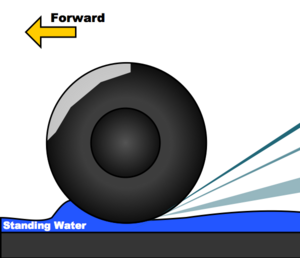Hydroplaning is a condition that occurs when water accumulates in front of a car’s tires ,between the rubber of the tires and the road’s surface. The water pressure in front of the tire forces a layer of water underneath the tire, reducing friction and causing the driver to lose control of the car.Although it can be a scary experience, especially if all four wheels undergo hydroplaning, the most important thing is to remember to stay calm. Stop Hydroplaning Ease your foot off the gas and steer your car with caution in the direction of the road. Do this until the car slows and you can feel your tires on the ground again.
2. Drive slowly and carefully to avoid skids, and maintain a mild pressure on your brake and gas. If you have to brake, do so in gentle pumps; if your car has anti-lock brakes, then you can brake normally. Make sure that you don’t lock the wheels, which will throw your car into a skid.
Avoid sudden acceleration and braking. Don’t make sudden turns, as these could throw your car off-course.
If your car begins to skid, stay calm and slowly release the gas pedal. Don’t panic! Continue to steer your car so that the front of your car is traveling in the right direction, which may involve constant changes in direction. Avoid braking unless your car has anti-lock brakes; if you do, you can brake firmly as you drive into the skid.
3. Be extra cautious on curvy roads, taking care to steer smoothly and to drive slowly.
4. Try to drive in the tire tracks left by the cars in front of you. That decreases the chance that water will build up in front of your tires and cause you to lose control of your car.
5. Understand how to handle specific hydroplaning conditions depending on direction of travel and the afflicted wheels.
If your vehicle has been driving straight, it will most likely feel loose and begin veering in either direction. Use larger steering movements to control the vehicle, and always steer in the direction that will make the front of your car travel straight.
If the drive wheels hydroplane, there might be an increase in your speedometer and engine RPM (revolutions per minute) as your tires begin to spin.[2] Counteract this by releasing the gas pedal, slowing down, and steering your car such that it travels straight on the road.
If the front wheels hydroplane, the car will start to slip towards the outside of the bend.Slow down and continue steering such that your car can travel straight.
If the back wheels hydroplane, the car’s rear end will begin to veer sideways into a skid. Steer your tires in the direction of the skid until the rear tires stop hydroplaning and come in contact with the ground, and then quickly steer in the opposite direction to straighten out your vehicle.
If all four wheels hydroplane, the car will slide forwards in a straight line, as though it were a large sled. It’s critical to remain calm, significantly slow down by releasing the gas pedal, and to continue controlling the steering wheel in the direction of the road. That way, when one or more tires regain traction with the ground, you are prepared to resume driving.
6. Prevent hydroplaning by replacing worn tires, maintaining good tire tread and keeping your tires properly inflated. Make sure you also practice driving safely in rainy conditions by slowing your speed.
Worn tires are more prone to hydroplaning because they have shallow tread depth. A tire with treads that are worn halfway will hydroplane 3-4mph slower than fresh tires.
Under inflated tires can deflect inwards, which makes the tire center higher and traps water easier.
Tires that are at the greatest risk for hydroplaning have a small diameter and are wide.
The longer and thinner the contact patch, the lower probability a tire will undergo hydroplaning. More vehicle weight on a properly inflated tire decreases the risk of hydroplaning, but the opposite is true for under inflated tires.
Have you tires check by the nearest auto repair shop. see more at http://www.wikihow.com


